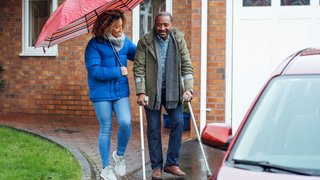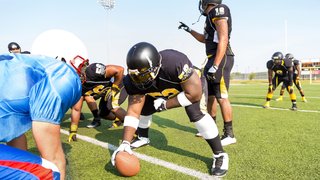Biceps tendonitis: How arthroscopic surgery relieves shoulder pain, reduces scarring
March 24, 2022

The biceps is probably the best-known muscle in the body. A symbol of strength, there’s even a flexed arm emoji to pump up its powerful image. Yet this two-headed muscle (that’s where the “bi” in biceps comes from) can’t do it all alone.
Your biceps rely on tendons, or tough strips of tissue to connect the upper arm muscle to the shoulder and elbow. The two tendons at the upper end of the biceps are attached to the shoulder joint – the longer of the two tendons is attached at almost a 90-degree turn, making it susceptible to shoulder pain.
When the biceps tendons are overused through repetitive movements, heavy lifting, wear and tear, or damaged in a traumatic injury, they can become inflamed and painful. In some cases, the biceps tendon pulls away from the shoulder or slips out of place. If physical therapy, rest, and medication don’t control the pain, you might need biceps tenodesis surgery to repair or re-anchor the damaged bicep tendons to your shoulder.
Traditionally, biceps tenodesis has been performed as an open shoulder surgery, requiring a 3-5 centimeter incision. But at UT Southwestern, our Orthopaedic Surgery team has been among the first to offer it as a minimally invasive arthroscopic procedure.
Using smaller incisions (less than 1cm) and advanced imaging technology, we can effectively repair strained and loosened biceps tendons – all on an outpatient basis. Arthroscopic biceps tenodesis may lower the risk of nerve damage or stiffening scar tissue, providing a satisfying patient outcome and a less painful recovery.
It’s truly a pleasure to help our patients get back to the activities they love pain-free, which is one of many reasons arthroscopic biceps tenodesis has become my favorite surgery to perform.
Crafting a ship in a bottle…or shoulder
With the distinct boundaries of the shoulder and narrow surgical incision sites, performing arthroscopic tenodesis is like crafting on a ship in a bottle. Rather than opening the arm and shoulder with 3-5cm incision, I make four tiny keyholes to access the damaged tendon.

Using an arthroscope – a lighted, flexible tube affixed with a camera – and advanced imaging displays, I navigate through the upper arm and shoulder. Then, I use miniature surgical tools to detach the tendon from the glenoid labrum, which is the shallow socket area in which the ball of the shoulder joint rests. If necessary, I remove the damaged portion of the tendon.
Then I drill an 8mm hole in the humerus, the bone that runs from the shoulder to the elbow, and attach a tendon anchor into the shoulder bone. Affixing the tendon to the anchor essentially gives it a new home without the problematic 90-degree turn. Then, we remove the arthroscope and tools and close the keyhole incisions. The procedure takes 1-2 hours, and most patients can go home the same day.
Related reading callout: Specialist spotlight: Paging Dr. Alison Cabrera
Who is a candidate for arthroscopic tenodesis?
For mild to moderate biceps tendonitis, arthroscopic or open shoulder surgery is an option if your pain interferes with daily activities and does not respond to rest and over-the-counter pain relievers. Patients typically start considering surgery when symptoms stop them from working, exercising, or sleeping comfortably.
The most common symptoms of biceps tendonitis include:
- Audible popping or clicking near the shoulder
- A bulge in the biceps, known as a Popeye deformity, caused by the tendon no longer being able to keep the biceps muscle tight
- Cramping of the biceps muscle with use of the arm
- Difficulty turning the hand palm up or palm down
- Dull ache that radiates from the upper arm to the elbow
- Sudden, sharp pain in the upper arm
As we age, our tendons stiffen, making us more susceptible to tendonitis. You may be at increased risk of biceps tendonitis if you perform repetitive motions long term. We often see patients who do a lot of overhead lifting at work, as well as athletes – particularly swimmers, tennis players, weightlifters, and baseball players.
Smoking reduces nutrient supply to the tendons, increasing the likelihood of injury and reducing proper healing. Certain corticosteroid medications can increase the risk for tendonitis because they deplete collagen. Also, these medications can mask pain symptoms, leading to additional overuse.
Related reading callout: 10 supplements and certain medications to pause before surgery
Tips to prevent biceps tendonitis
While some injuries are inevitable, simple changes can reduce the risk of biceps tendonitis:
- Strengthen your upper back: Think of a crane – if the base of the crane is strong, the arm of the crane will be strong. It’s the same with your back, shoulder, and arms.

- Stretch before activity: Warm tendons and muscles are more flexible and less likely to be damaged.
- Change up your activities: If you are a one-sport athlete, incorporate other forms of exercise into your training. Cross-training builds whole-body strength and reduces the risk of overuse injuries. Talk with your doctor and employer if you are concerned about the volume repetitive movements you perform at work.
- Mind your form and posture: Establish proper mechanics for movement, such as throwing a baseball or lifting over your head. Practicing good posture throughout the day reduces unnecessary strain on your tendons.
- Quit smoking: And avoid secondhand smoke, which also reduces your body’s ability to avoid tendon injury and heal inflammation.
Many patients with tendonitis respond well to rest, anti-inflammatory medication such as ibuprofen, and/or physical therapy. If these conservative treatments don’t work, ask your doctor whether biceps tenodesis might be an appropriate option.
Arthroscopic biceps tenodesis is new and very few surgeons in the Dallas-Fort Worth area use this technique. So, there aren’t many studies yet to compare patient outcomes of arthroscopic tenodesis and traditional open tenodesis. I am planning to conduct a study to identify benefits and compare outcomes with the arthroscopic method.
Anecdotally, the physical therapists who work with my patients say those who get minimally invasive surgery tend to have less pain and scarring and return to mobility faster. In the future, I expect that the arthroscopic approach will become more widely available and eventually it might become the standard of care for biceps tendonitis.
To discuss your shoulder pain with one of our orthopedic surgeons, call 214-645-8300 or request an appointment online.











